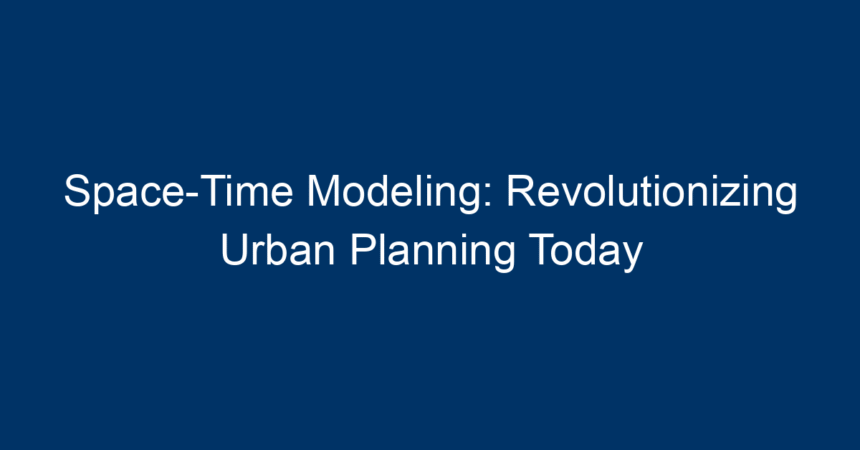Urban planning has undergone a seismic shift in recent years, championed by advanced technologies and innovative methodologies. Among these, space-time modeling emerges as a game-changer, providing urban planners and stakeholders with insights that were once impossible to achieve. This article delves deep into the concept of space-time modeling, its applications, and the transformative impact it has on urban planning today.
Understanding Space-Time Modeling
What is Space-Time Modeling?
At its core, space-time modeling is a framework that integrates spatial and temporal data to analyze events and processes over time and place. This multidimensional approach allows planners to visualize changes in urban landscapes, understand dynamics in human behavior, and forecast future trends. By combining geographic information systems (GIS) with temporal data, planners can observe how urban areas evolve, how populations migrate, and how resources are utilized over time.
The Importance of Space-Time in Urban Planning
Urban environments are inherently dynamic, characterized by constant changes in demographics, infrastructure, and natural phenomena. Traditional models often fail to capture these complexities, leading to suboptimal planning decisions. Space-time modeling addresses these gaps by:
- Visualizing Trends: It enables the visualization of urbanization patterns and how they shift over time.
- Forecasting Changes: By analyzing spatial-temporal data, planners can better predict future challenges, such as traffic congestion or housing shortages.
- Enhancing Decision-Making: Decision-makers gain access to actionable insights that drive effective urban policies.
Applications of Space-Time Modeling in Urban Planning
Space-time modeling has a diverse range of applications, each benefiting urban planners and policymakers in unique ways:
1. Transportation Planning
Transportation is a critical component of urban infrastructure. Space-time modeling allows planners to:
- Analyze Traffic Flows: By studying how traffic varies throughout the day, planners can identify peak hours and adjust infrastructure accordingly.
- Predict Public Transport Needs: Understanding the movement patterns of residents helps in planning efficient public transport routes and schedules.
- Optimize Traffic Signals: Real-time data can be used to modify traffic signals, enhancing flow during rush hours.
2. Land Use Management
With urban areas growing rapidly, effective land use management is essential to ensure sustainability. Space-time modeling aids planners in:
- Zoning Regulation: By analyzing spatial trends, planners can make informed decisions about zoning regulations to balance residential and commercial spaces.
- Analyzing Green Spaces: This approach helps identify areas that would benefit from increased green spaces, contributing to urban biodiversity and residents’ quality of life.
3. Disaster Management
Natural disasters pose significant risks to urban areas. Space-time modeling enhances disaster preparedness by:
- Risk Assessment: By understanding historical data on disasters, planners can identify high-risk areas and devise mitigation strategies.
- Resource Allocation: During an emergency, real-time models can help allocate resources efficiently, ensuring timely response and recovery.
4. Social Dynamics and Community Engagement
Urban planning must account for the social fabric of communities. Space-time modeling allows for:
- Understanding Demographics: Analyzing migration patterns helps planners understand how neighborhoods are changing, enabling them to address social and economic disparities.
- Community Participation: Planners can use space-time models to engage communities, visualizing proposals and collecting public feedback to create more inclusive urban policies.
The Technological Backbone of Space-Time Modeling
Geographic Information Systems (GIS)
GIS is the cornerstone of space-time modeling. It enables the visualization of spatial data, allowing planners to overlay different datasets—such as traffic patterns, population density, and land usage. This technology makes it easier to see relationships between various elements of urban landscapes.
Big Data
The availability of big data facilitates more accurate space-time modeling. Sources of big data, including social media, mobile applications, and satellite imagery, provide a wealth of information that can be analyzed to inform urban planning strategies.
Machine Learning and AI
Machine learning algorithms enhance space-time modeling by enabling the analysis of vast datasets. They can identify patterns not immediately apparent, thus providing deeper insights into urban dynamics. AI can also assist in predictive analytics, helping urban planners anticipate future changes.
Challenges in Implementing Space-Time Modeling
Despite its benefits, several challenges hinder the widespread adoption of space-time modeling in urban planning:
Data Quality and Availability
Reliable data is crucial for effective space-time modeling. However, inconsistencies in data collection processes, along with gaps in historical data, can lead to skewed insights. Urban planners must prioritize data quality and invest in efficient data collection methodologies.
Interdisciplinary Collaboration
Space-time modeling requires contributions from various disciplines, including urban planning, geography, sociology, and data science. Fostering collaboration among these fields can be challenging but is essential for maximizing the benefits of space-time modeling.
Ethical Considerations
As with any data-driven approach, ethical considerations surrounding privacy and data usage must be addressed. Urban planners need to ensure that they obtain consent for data usage from individuals and communities while being transparent about their methodologies.
Conclusion: Actionable Insights for Urban Planners
The revolution brought about by space-time modeling is unstoppable. Urban planners looking to harness its potential should consider the following action steps:
-
Invest in Data Infrastructure: Prioritize investments in high-quality data collection tools and methodologies to ensure accurate space-time analyses.
-
Embrace Technology: Leverage GIS and machine learning technologies to improve modeling accuracy and predictive capabilities.
-
Foster Collaboration: Build interdisciplinary teams that encompass various expertise, essential for undertaking comprehensive urban analysis.
-
Engage Communities: Involve local communities in the planning process, utilizing space-time models to visualize proposals and gather feedback.
- Stay Informed: As technology evolves, urban planners should continuously seek training and professional development opportunities to stay current with best practices in space-time modeling.
By adopting these strategies, urban planners can revolutionize their approach and create dynamic, responsive urban environments that meet the needs of current and future generations. With space-time modeling as a guiding framework, the possibilities for innovative urban planning are limitless.




